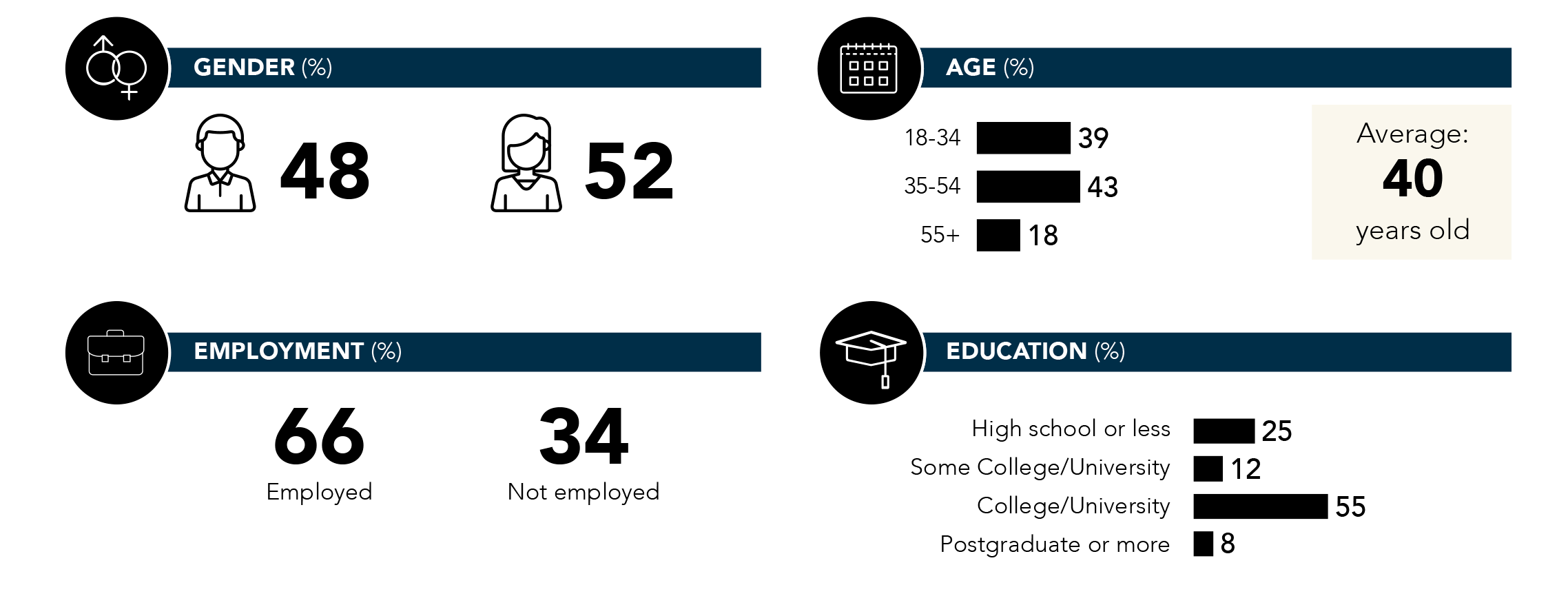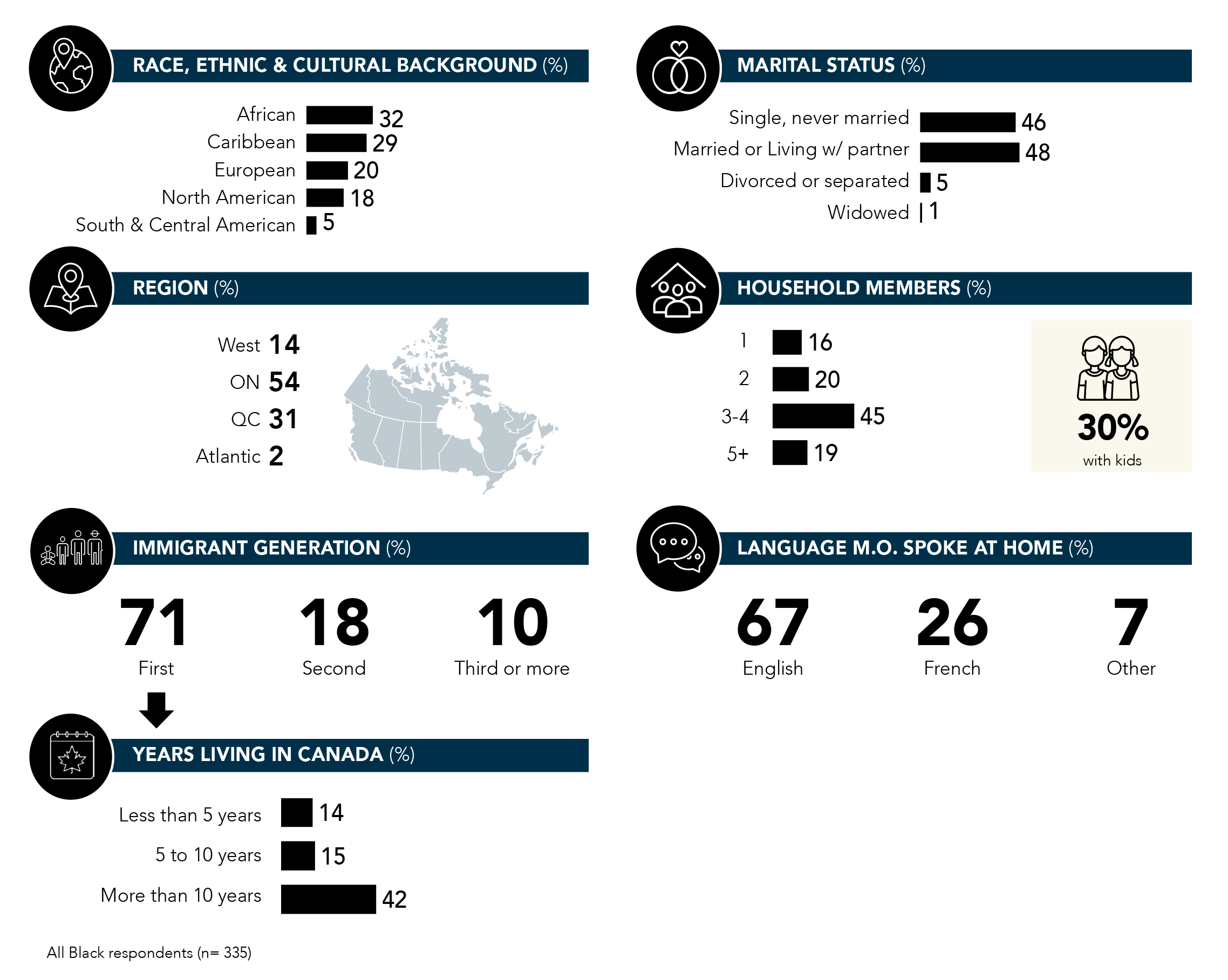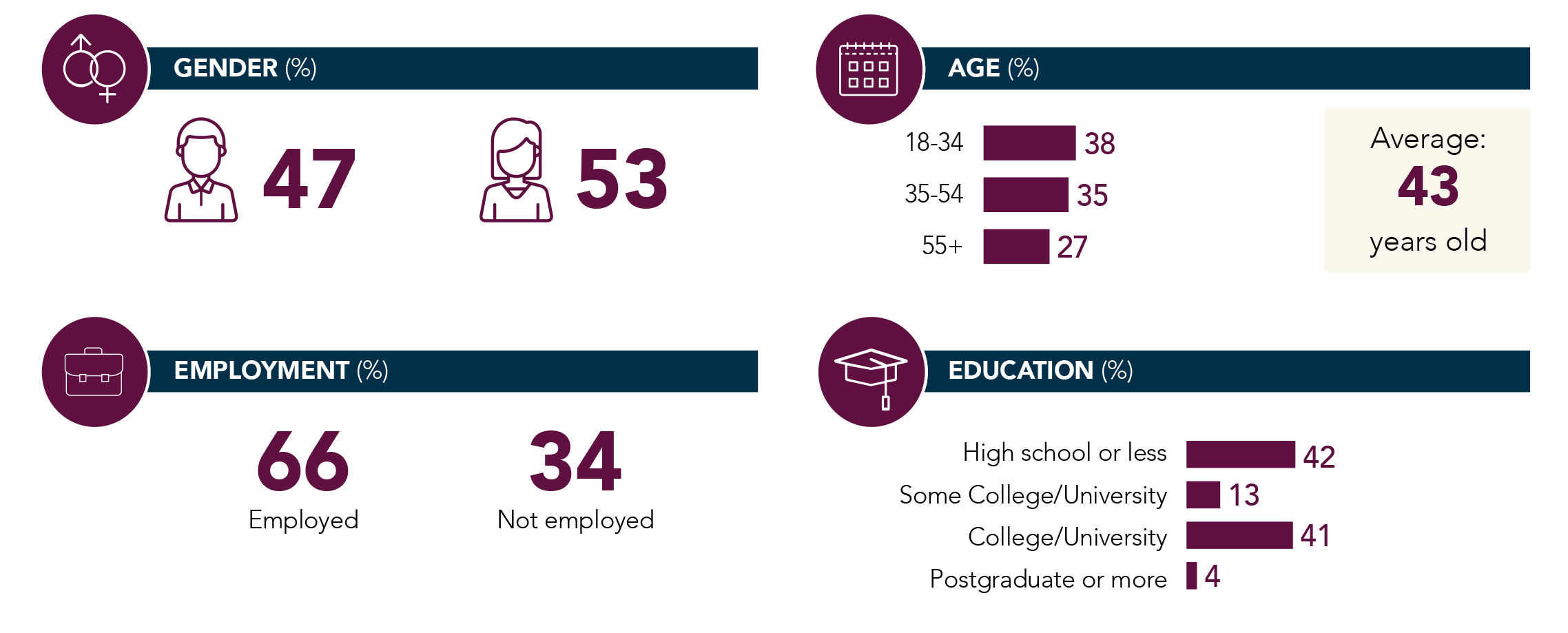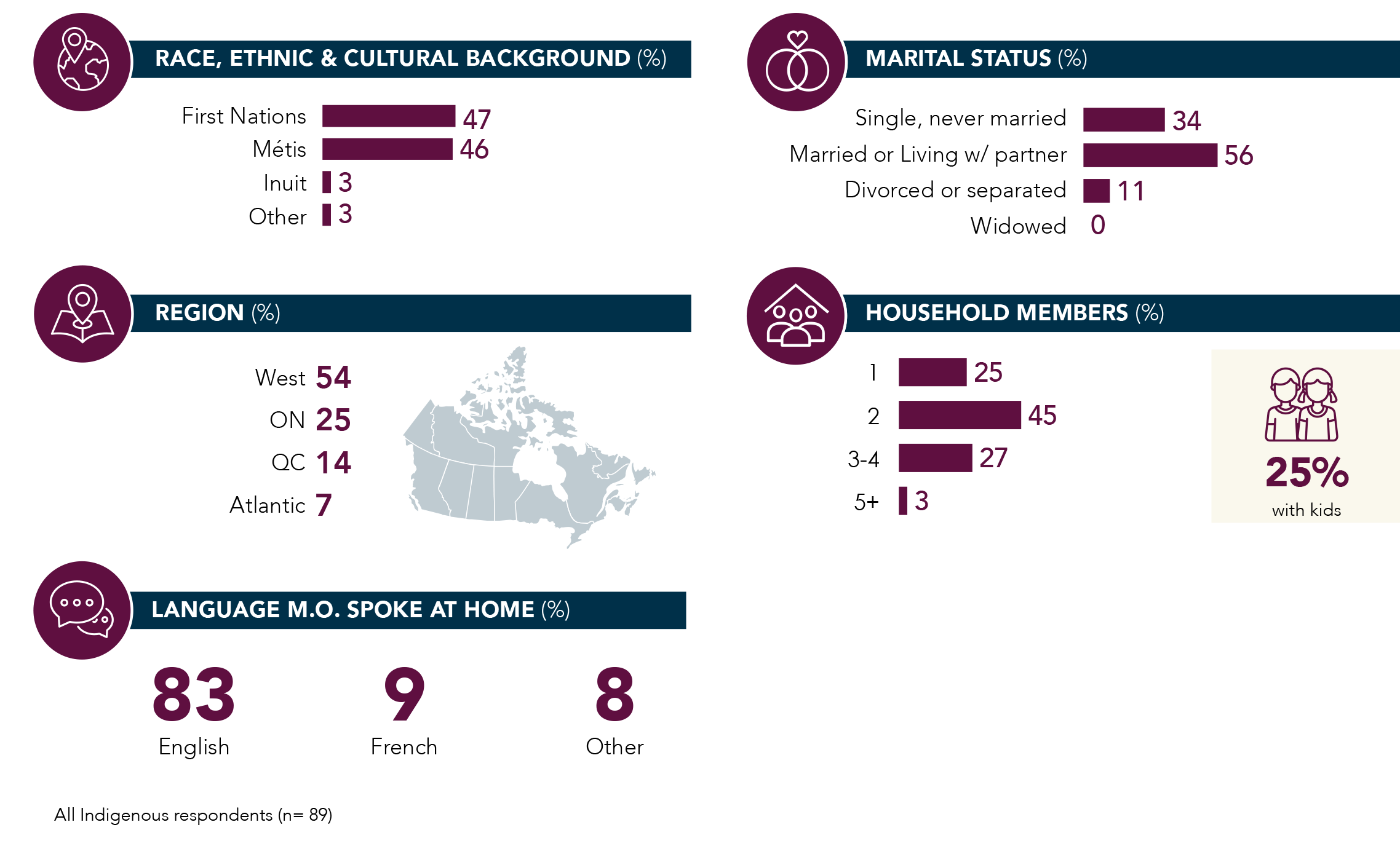
A PORTRAIT OF BLACK, INDIGENOUS AND PEOPLE OF COLOUR AUDIENCES
VIEWING HABITS AND PREFERENCES
BLACK AUDIENCES
WHO ARE THEY?


HOW MUCH ARE THEY WATCHING?

Most Black audience participants (52%) reported watching entertainment content every day or almost every day, with 32% indicating they watch 4 hours or more of content on a daily basis.
WHAT ARE THEY WATCHING?
Movies watched on TV are the most popular type of content reported by Black audience participants (85%), followed by live-action scripted TV series (56%) and news, current affairs, and information (53%). Among those who watch live-action scripted TV series, drama is the most frequently watched content type (77%), followed by crime (69%), suspense (67%) and sitcom/comedy (62%).
Most of this viewing occurs only in English or French (58%). In terms of content viewed in a language other than English or French (42%), movies are the standout selection (28%).
Among participants who identified as immigrants or as having immigrant parents, 46% consume content from their or their parents’ country/countries of origin. In this case, the most-viewed content was split between movies (24%) and news, current affairs, and information (20%) with all other types of content viewed significantly less often.
HOW ARE THEY WATCHING?
TV remains the most popular device used to watch entertainment content (81%), ahead of smartphones (51%) and computers/laptops (47%).
Participants reported using tablets (27%), set-top boxes such as AppleTV and Roku (12%) and game consoles like PS4 (11%) significantly less frequently.

Streaming platforms were the most common means of accessing entertainment content (80%), no matter which device was being used, with typical streaming platforms, such as Netflix, AppleTV+, and Disney+ being the most popular (71%). Live television (60%) and on-demand (via TV set-top box) (29%) were also reported, while movie theatres and screening sessions (26%), set-top box (26%), and offline content (13%) were accessed less often.
WHY ARE THEY WATCHING?

Black audience participants indicated that genre (62%), storylines (49%) and characters (37%) are significant criteria for choosing the entertainment content they usually watch – the highest percentage among all participants. Personal reasons were also important, especially for the role entertainment content serves in providing an escape (52%). Awards and recommendations were also significant, with suggestions by streaming services (44%) and popular opinion (37%) having the most influence in their decision-making.
INDIGENOUS AUDIENCES
WHO ARE THEY?


HOW MUCH ARE THEY WATCHING?

56% of Indigenous audience participants indicated they watch entertainment content every day or almost every day, with 42% reporting 4 hours or more of daily viewing time.
WHAT ARE THEY WATCHING?
82% of Indigenous audience participants reported watching movies, followed by documentaries or biographies (53%) and news, current affairs, and information (48%). The vast majority of this content is viewed only in English or French (74%).
HOW ARE THEY WATCHING?
TV is the most commonly used device to view entertainment content (71%), followed by computers or laptops (39%) and smartphones (33%). Notably, the use of set-top boxes (22%) and game consoles (14%), though less common, are the highest for Indigenous audiences compared with other groups.

Streaming content is, across all devices, the most frequently used platform for watching entertainment content (71%), and in particular, streaming platforms such as Netflix, Apple TV+, and Disney+ (66%). Live television (42%) is also popular. Interestingly, although offline content (DVD, recorded content, etc.) remains one of the least-accessed platforms, Indigenous audiences reported watching offline content almost twice as much (24%) as Black and People of Colour audiences.
WHY ARE THEY WATCHING?

Genre (47%) and storylines (30%) are key factors for Indigenous audiences when choosing entertainment content. Awards/recommendations are also important, with 39% relying on recommendations from friends or family, and 35% following suggestions from a streaming service.
Among the personal reasons for watching reported by Indigenous participants, providing an escape or opportunity to unwind was the most common (42%), followed by a desire for educational or thought-provoking content (25%).
PEOPLE OF COLOUR AUDIENCES
WHO ARE THEY?


HOW MUCH ARE THEY WATCHING?

57% of People of Colour audience participants indicated they watch entertainment content every day or almost every day, but for less time than any other group: 21% indicate watching 4 hours or more, 41% watch 2-4 hours, and 38% watch 1-2 hours of entertainment content daily.
WHAT ARE THEY WATCHING?
85% of People of Colour audience participants reported watching movies on TV, followed by news, current affairs, and information (47%) and documentaries or biographies (41%). Only 24% of People of Colour audience participants reported watching content only in English or French.
This study was conducted during the COVID-19 pandemic, when audiences were spending more time at home. Industry trends reported by the Canada Media Fund in 20211 showed an acceleration of viewing trends toward streaming services and overall increases in time spent viewing entertainment content. Indeed, Black and Indigenous participants in the current study, in particular, reported more time spent viewing content on a typical day. It is possible that the longer viewing time available is contributing to increased movie consumption, compared to episodic TV.
1 Canada Media Fund. (2021). Pause and rethink: Annual trends report in the audiovisual industry.
HOW ARE THEY WATCHING?
Participants report watching most entertainment content on TV (73%) followed by computers or laptops (54%)—of which they are the highest users—and smartphones (50%).

Streaming content is, across all devices, the most frequently used platform for watching entertainment content (87%). Streaming platforms such as Netflix, Apple TV+, and Disney+ (77%) are the most used.
YouTube is used by 59% of People of Colour audience participants—the most across all groups. These habits are perhaps best understood considering the significant proportion of participants who identified as immigrants or as having parents who are immigrants, the majority of whom reported watching entertainment content (76%) in languages other than English or French. And 70% of People of Colour participants reported watching content from their or their parents’ country/countries of origin, with movies (45%) and news, current affairs, and information (21%) as the most common types.
WHY ARE THEY WATCHING?

71% of People of Colour audience participants reported Awards/Recommendations among their primary criteria when choosing entertainment content. Popular opinion (44%), recommendations from friends or family (41%) and suggestions by a streaming service (40%) were most common, with Awards/Nominations and Critical Reviews exerting considerably less influence (26% and 23% respectively). These patterns were elaborated upon by the participants who were engaged qualitatively2 (“EyeJournal participants”):
Older participants consistently expressed a strong sense of ‘shared identity’, with several participants introducing themselves as ‘belonging’ to a group (Black, Indigenous, Asian). Younger participants also showed patterns of belonging and connection. In this case, participants recognized a growing ‘I’ within the ‘We’ that seemed to emphasize peer groups or relatable popular figures more than specific ethnic or cultural communities, citing inspirational role models who they think have ‘done the right thing’ (e.g., Pink, Lady Gaga, Reese Witherspoon) not necessarily owing to a cultural affinity.
 |
I find people like Priyanka Chopra, Oprah Winfrey relatable; they seem like me and I feel there is a lot of similarities between them and me – as women, as people who are not white, people who are immigrants, etc. (Woman, 25-34, Black) |
These feelings of community, belonging, and connection offer insight into how and why recommendations take such precedence in shaping viewing behaviours, and indeed, how the source of recommendations factors into consumption habits.
2 This study included a qualitative investigation into the perceptions, experiences, and expectations of Black, Indigenous and People of Colour audiences using IPSOS’ proprietary EyeJournal. The EyeJournal is an online platform that invites participants to capture and reflect on their own viewing habits over the course of three days. This method goes beyond traditional viewing diaries by permitting researchers to interact with participants in response to what they capture in ‘real time’. In this way, the EyeJournal experience is a combination of auto-ethnography (where participants record and reflect on their own behaviours); questions provided in text form (participants may respond using text or video) and online interaction with moderators.
DIVERSITY ONSCREEN AND MOTIVATION TO WATCH
Cultural Content and Cast and Crew were among the lowest-rated criteria motivating entertainment choices indicated by survey participants. EyeJournal participants, however, helped clarify that these results should not be understood to mean that cultural content is unimportant. On the contrary, diversity and representation were prioritized across all EyeJournal participants, many of whom expressed clear desires for more quality content driven by authentic portrayals of Black, Indigenous and People of Colour characters and stories. Moreover, all survey respondents underscored the importance of diversity in every area of content creation (see Diversity On Screen later in this report).
It is possible, therefore, that the reduced importance of Cultural Content as a decision-making factor captured by the survey is a reflection of the content available – that is, the current lack of authentic, culturally relevant, inclusive content prevents it from being a primary driver of behaviour; there is simply not enough to choose from.
SPOTLIGHT ON CANANDIAN CONTENT
Overall, participants consistently reported awareness of viewing Canadian content, with 26% indicating they do so for reasons related to pride in and/or support for Canadian content.

Among Black, Indigenous and People of Colour audiences who know when they are watching Canadian content3, it comprises 26%-32% of their viewing time.
While participants cited several reasons for watching Canadian content, including wanting to know what is going on in Canada or wanting to learn about Canadian culture, few participants referenced program quality or feeling connected to the stories being told, which highlights a significant opportunity for producers to better understand and engage these audiences.
3 For the purposes of this study, “Canadian entertainment content” means filmed entertainment that is produced and/or created by Canadian creators and producers, primarily for Canadian broadcasters and their streaming services.
COVID-19 CONSIDERATIONS
This study occurred during the second year of the COVID-19 pandemic, during which significant segments of the Canadian population (particularly in Ontario and British Columbia) experienced lengthy periods of lockdown and social isolation. For many communities, these lockdown periods prevented access to viewing experiences they might have otherwise engaged in, like going to movie theatres.
Although race-based audience data has not previously been collected in Canada, preventing direct comparisons to pre-pandemic viewing habits, general population trends suggest a decrease in movie-going during the pandemic period. It is expected, therefore, that these societal constraints have also influenced the viewing behaviours of Black, Indigenous, and People of Colour audiences.
Other notable changes in behaviour and viewing habits include:
-
- Preferences for shows that do not reflect current reality, including literal reality (e.g., not watching something about a pandemic, not watching violent films/shows) and emotional reality (e.g., not watching sad/angry/unhappy things and using happy/uplifting/inspirational shows/films to help their own moods). While these preferences were also typical in the general population before the pandemic, EyeJournal participants underscored the intentionality of making viewing choices that support their mood/needs during this time